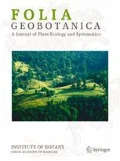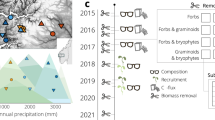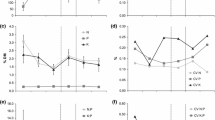Abstract
Quantifying species relative abundances in plant communities remains a key issue for the assessment of community functional structure. This is particularly challenging when non-destructive estimates are required over time. We tested whether the point intercept method (PIM), originally developed for low-diverse communities, is relevant for assessing the aboveground biomass and functional structure of highly diverse, low-productive Mediterranean grasslands. We sampled 18 communities with the PIM along a gradient of soil depth and texture, twice over the growing season. After each sampling period, we harvested the aboveground biomass in order to measure species biomass and to assess species richness and community functional structure with plant height, leaf area and leaf dry matter content (LDMC). We investigated the relationship between point intercept measurements and aboveground biomass at three hierarchical levels (species, growth-form and community) to find generalizable calibration equations for estimating community biomass and tested for sensitivity of estimates to community structure. We then compared the community weighted mean (CWM) and variance (CWV) of LDMC, calculated with and without calibration. Differences in species growth strategy and phenology strongly impacted biomass estimates at both the species and the community level. These differences were, however, successfully accounted for by growth-form specific calibrations, which provided accurate estimates without any influence of community structure. Lack of calibration may have dramatic consequences on functional structure assessment by inducing errors in estimates of CWV up to 80 %, depending on growth-form proportions. This work contributes to a better understanding of the possible methodological biases induced during sampling with the PIM, when quantifying species relative abundances for functional structure assessment in complex communities.




Similar content being viewed by others
Abbreviations
- CWM:
-
Community weighted mean
- CWV:
-
Community weighted variance
- LDMC:
-
Leaf dry matter content
- PIM:
-
Point intercept method
- RGR:
-
Relative growth rate
- RMAE:
-
Relative mean absolute error
- SLA:
-
Specific leaf area
- SMA:
-
Standardized major axis
References
Axmanová I, Tichý L, Fajmonová Z, Hájková P, Hettenbergerová E, Li C-F, Merunková K, Nejezchlebová M, Otýpková Z, Vymazalová M, Zelený D (2012) Estimation of herbaceous biomass from species composition and cover. Appl Veg Sci 15:580–589
Bernard-Verdier M, Navas M-L, Vellend M, Violle C, Fayolle A, Garnier E (2012) Community assembly along a soil depth gradient: contrasting patterns of plant trait convergence and divergence in a Mediterranean rangeland. J Ecol 100:1422–1433
Bret-Harte MS, Garcia EA, Sacre VM, Whorley JR, Wagner JL, Lippert SC, Chapin FS (2004) Plant and soil responses to neighbour removal and fertilization in Alaskan tussock tundra. J Ecol 92:635–647
Bråthen KA, Hagberg O (2004) More efficient estimation of plant biomass. J Veg Sci 15:653–660
Byrne KM, Lauenroth WK, Adler PB, Byrne CM (2011) Estimating aboveground net Primary production in grasslands: a comparison of nondestructive methods. Rangeland Ecol Managem 64:498–505
Cagney J, Cox SE, Booth DT (2011) Comparison of point intercept and image analysis for monitoring rangeland transects. Rangeland Ecol Managem 64:309–315
Catchpole WR, Wheeler CJ (1992) Estimating plant biomass: a review of techniques. Austral Ecol 17:121–131
Clark PE, Hardegree SP, Moffet CA, Pierson FB (2008) Point sampling to stratify biomass variability in sagebrush steppe vegetation. Rangeland Ecol Managem 61:614–622
Cockayne L (1926) Aims and methods in the study of vegetation. In Tansley AG, Chipp TF (eds) Tussock grassland investigation in New Zealand. Crow, Loncadon, pp 349–361
Cornelissen JHC, Lavorel S, Garnier E, Díaz S, Buchmann N, Gurvich DE, Reich PB, Steege H Ter, Morgan HD, Heijden MG Van Der, Pausas JG, Poorter H (2003) A handbook of protocols for standardised and easy measurement of plant functional traits worldwide. Austral J Bot 51:335–380
Daget P, Poissonet J (1969) Analyse phytologique des prairies: applications agronomiques. CNRS-CEPE Doc 48, Montpellier
Damgaard C, Riis-Nielsen T, Schmidt IK (2009) Estimating plant competition coefficients and predicting community dynamics from non-destructive pin-point data: a case study with Calluna vulgaris and Deschampsia flexuosa. Pl Ecol 201:687–697
Díaz S, Cabido M (2001) Vive la différence: plant functional diversity matters to ecosystem processes. Trends Ecol Evol 16:646–655
Díaz S, Lavorel S, De Bello F, Quétier F, Grigulis K, Robson TM (2007) Incorporating plant functional diversity effects in ecosystem service assessments. Proc Natl Acad Sci USA 104:20684–20689
Fayolle A (2008) Structure des communautés de plantes herbacées sur les grands causses: stratégies fonctionnelles des espèces et interactions interspecifiques. PhD Thesis, Montpellier SupAgro, Montpellier
Frank D, McNaughton S (1990) Aboveground biomass estimation with the canopy intercept method: a plant growth form caveat. Oikos 57:57–60
Frenette-Dussault C, Shipley B, Léger J-F, Meziane D, Hingrat Y (2012) Functional structure of an arid steppe plant community reveals similarities with Grime’s C-S-R theory. J Veg Sci 23:208–222
Ganguli AC, Vermeire LT, Mitchell RB, Wallace MC (2000) Comparison of four nondestructive techniques for estimating standing crop in shortgrass plains. Agron J 92:1211–1215
Garnier E, Navas M-L (2012) A trait-based approach to comparative functional plant ecology: concepts, methods and applications for agroecology. A review. Agron Sustainable Developm 32:365–399
Garnier E, Shipley B, Roumet C, Laurent G (2001a) A standardized protocol for the determination of specific leaf area and leaf dry matter content. Funct Ecol 15:688–695
Garnier E, Laurent G, Bellmann A, Debain S, Berthelier P, Ducout B, Roumet C, Navas M-L (2001b) Consistency of species ranking based on functional leaf traits. New Phytol 152:69–83
Garnier E, Cortez J, Billès G, Navas M-L, Roumet C, Debussche M, Laurent G, Blanchard A, Aubry D, Bellman A, Neill C, Toussaint J-P (2004) Plant functional markers capture ecosystem properties. Ecology 85:2630–2637
Godínez-Alvarez H, Herrick JE, Mattocks M, Toledo D, Van Zee J (2009) Comparison of three vegetation monitoring methods: Their relative utility for ecological assessment and monitoring. Ecol Indicators 9:1001–1008
Goodall DW (1952) Some considerations in the use of point quadrats for the analysis of vegetation. Austral J Sci Res Ser B 5:1–41
Grime JP (2006) Trait convergence and trait divergence in herbaceous plant communities: Mechanisms and consequences. J Veg Sci 17:255
Groeneveld D (1997) Vertical point quadrat sampling and an extinction factor to calculate leaf area index. J Arid Environm 36:475–485
Hakl J, Hrevušová Z, Hejcman M, Fuksa P (2012) The use of a rising plate meter to evaluate lucerne (Medicago sativa L.) height as an important agronomic trait enabling yield estimation. Grass Forage Sci 67:589–596
Harmoney KR, Moore KJ, George JR, Brummer EC, Russell JR (1997) Determination of pasture biomass using four indirect methods. Agron J 89:665
Hobbie SE, Shevtsova A, III FS Chapin (1999) Plant responses to species removal and experimental warming in Alaskan tussock tundra. Oikos 84:417–434
Hudson JMG, Henry GHR (2010) High Arctic plant community resists 15 years of experimental warming. J Ecol 98:1035–1041
Jarchow ME, Liebman M (2012) Nutrient enrichment reduces complementarity and increases priority effects in prairies managed for bioenergy. Biomass Bioenergy 36:381–389
Jonasson S (1988) Evaluation of the point intercept method for the estimation of plant biomass. Oikos 52:101–106
Lavorel S, Garnier E (2002) Predicting changes in community composition and ecosystem functioning from plant traits: revisiting the Holy Grail. Funct Ecol 16:545–556
Lavorel S, Grigulis K, McIntyre S, Williams NSG, Garden D, Dorrough J, Berman S, Quétier F, Thébault A, Bonis A (2008) Assessing functional diversity in the field – methodology matters! Funct Ecol 22:134–147
Lepš J, De Bello F, Lavorel S, Berman S (2006) Quantifying and interpreting functional diversity of natural communities: practical considerations matter. Preslia 78:481–501
Levy EB, Madden EA (1933) The point method of pasture analysis. New Zealand J Agric 46:267–279
Lorentzen S, Roscher C, Schumacher J, Schulze E-D, Schmid B (2008) Species richness and identity affect the use of aboveground space in experimental grasslands. Perspect Pl Ecol 10:73–87
Martin RC, Astatkie T, Cooper JM, Fredeen a. H (2005) A comparison of methods used to determine biomass on naturalized swards. J Agron Crop Sci 191:152–160
Mason NWH, MacGillivray K, Steel JB, Wilson JB (2003) An index of functional diversity. J Veg Sci 14:571–578
Mason NWH, Mouillot D, Lee WG, Wilson JB (2005) Functional richness, functional evenness and functional divergence: the primary components of functional diversity. Oikos 111:112–118
Muséum national d’Histoire naturelle (ed) (2003−2013) Inventaire national du Patrimoine naturel. Available at: http://inpn.mnhn.fr
McLaren JR, Turkington R (2010) Ecosystem properties determined by plant functional group identity. J Ecol 98:459–469
Olofsson J (2001) Influence of herbivory and abiotic factors on the distribution of tall forbs along a productivity gradient: a transplantation experiment. Oikos 94:351–357
Petchey OL, Gaston KJ (2006) Functional diversity: back to basics and looking forward. Ecol Lett 9:741–58
Poorter H, Vijver CADM, Boot RGA, Lambers H (1995) Growth and carbon economy of a fast-growing and a slow-growing grass species as dependent on nitrate supply. Pl Soil 171:217–227
Poorter H, Garnier E (2007) Ecological significance of inherent variation in relative growth rate and its components. In Pugnaire FI, Valladares F (eds) Functional plant ecology. Ed. 2. CRC Press, Boca Raton, Florida, pp 67–100
Poorter H, Niklas KJ, Reich PB, Oleksyn J, Poot P, Mommer L (2012) Biomass allocation to leaves, stems and roots: meta-analyses of interspecific variation and environmental control. New Phytol 193:30–50
Pérez-Ramos IM, Roumet C, Cruz P, Blanchard A, Autran P, Garnier E (2012) Evidence for a “plant community economics spectrum” driven by nutrient and water limitations in a Mediterranean rangeland of southern France. J Ecol 100:1315–1327
R Development Core Team (2011) R: A language and environment for statistical computing. R Foundation for Statistical Computing, Vienna. Available at: http://www.r-project.org/
Redjadj C, Duparc A, Lavorel S, Grigulis K, Bonenfant C, Maillard D, Saïd S, Loison A (2012) Estimating herbaceous plant biomass in mountain grasslands: a comparative study using three different methods. Alpine Bot 122:57–63
Robroek BJM, Smart RP, Holden J (2010) Sensitivity of blanket peat vegetation and hydrochemistry to local disturbances. Sci Total Environm 408:5028–34
Shaver GR, Bret-harte MS, Jones MH, Johnstone J, Laundre J, Chapin FS (2001) Species composition interacts with fertilizer to control long-term change in tundra productivity. Ecology 82:3163–3181
Shen M, Tang Y, Klein J, Zhang P, Gu S, Shimono A, Chen J (2008) Estimation of aboveground biomass using in situ hyperspectral measurements in five major grassland ecosystems on the Tibetan Plateau. J Pl Ecol 1:247–257
Sonnier G, Shipley B, Navas M-L (2010) Quantifying relationships between traits and explicitly measured gradients of stress and disturbance in early successional plant communities. J Veg Sci 21:1014–1024
Spasojevic MJ, Suding KN (2012) Inferring community assembly mechanisms from functional diversity patterns: the importance of multiple assembly processes. J Ecol 100:652–661
Stampfli A, Fuhrer J (2010) Spatial heterogeneity confounded ozone-exposure experiment in semi-natural grassland. Oecologia 162:515–22
Suter M, Ramseier D, Connolly J, Edwards PJ (2010) Species identity and negative density dependence lead to convergence in designed plant mixtures of twelve species. Basic Appl Ecol 11:627–637
Vermeire LT, Ganguli AC, Gillen RL (2002) A robust model for estimating standing crop across vegetation types. J Range Managem 55:494–497
Vittoz P, Guisan A (2007) How reliable is the monitoring of permanent vegetation plots? A test with multiple observers. J Veg Sci 18:413–422
Warton DI, Wright IJ, Falster DS, Westoby M (2006) Bivariate line-fitting methods for allometry. Biol Rev 81:259–91
Warton DI, Duursma R a., Falster DS, Taskinen S (2012) smatr 3- an R package for estimation and inference about allometric lines. Methods Ecol Evol 3:257–259
Whitbeck M, Grace JB (2006) Evaluation of non-destructive methods for estimating biomass in marshes of the upper Texas, USA coast. Wetlands 26:278–282
Wilson JB (2010) Cover plus: ways of measuring plant canopies and the terms used for them. J Veg Sci 22:197–206
Yurkonis KA, Wilsey BJ, Moloney KA (2012) Initial species pattern affects invasion resistance in experimental grassland plots. J Veg Sci 23:4–12
Acknowledgments
This work was funded by the ANR programme O2LA (09-STRA-09). We thank the experimental station “INRA-La Fage” for access to the facilities, and Jean Richarte and Caroline Demange for their valuable supports during field work and laboratory sorting. We also thank Philippe Choler and Florence Volaire for helpful discussions and comments on an early version of the manuscript.
Author information
Authors and Affiliations
Corresponding author
Electronic supplementary material
Below is the link to the electronic supplementary material.
ESM 1
(PDF 217 kb)
Rights and permissions
About this article
Cite this article
Barkaoui, K., Bernard-Verdier, M. & Navas, ML. Questioning the Reliability of the Point Intercept Method for Assessing Community Functional Structure in Low-Productive and Highly Diverse Mediterranean Grasslands. Folia Geobot 48, 393–414 (2013). https://doi.org/10.1007/s12224-013-9172-2
Received:
Revised:
Accepted:
Published:
Issue Date:
DOI: https://doi.org/10.1007/s12224-013-9172-2
Keywords
- Aboveground biomass
- Community functional structure
- Mediterranean grasslands
- Point intercept method
- Species richness
- Vegetation sampling




